skip to main |
skip to sidebar
So here I am with the first offering (luckily not burnt) of the year - roasted brussels sprouts, which I simply adore. The recipe is simpler than simple and I've been eating this for four days straight - although not JUST this, of course, otherwise I'd be my own jet-pack being propelled around by - er, you know, natural gas. (Not petroleum - respect for the earth's resources and all that).
I love the flavour of balsamic vinegar and it goes beautifully well with the sprouts. It doesn't hurt the mushrooms either, although you don't HAVE to use mushrooms at all if you don't want to.
Do try this, if you're a brussels sprouts fan like me.
Recipe for: Balsamic roasted brussels sprouts and mushrooms
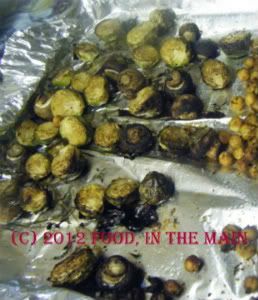 Ingredients:
Ingredients:
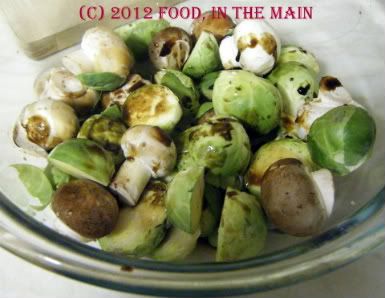 12-15 medium sized brussels sprouts, trimmed and sliced vertically in half
10 baby chestnut mushrooms, wiped clean
1-2 tbsp good quality balsamic vinegar
1 tbsp Worcestershire sauce
1 tsp olive oil or 2-3 sprays of Pam
1/2 tsp dried thyme or a few sprigs of fresh (I used lemon thyme)
Salt and freshly-milled pepper to taste
Method:
12-15 medium sized brussels sprouts, trimmed and sliced vertically in half
10 baby chestnut mushrooms, wiped clean
1-2 tbsp good quality balsamic vinegar
1 tbsp Worcestershire sauce
1 tsp olive oil or 2-3 sprays of Pam
1/2 tsp dried thyme or a few sprigs of fresh (I used lemon thyme)
Salt and freshly-milled pepper to taste
Method:
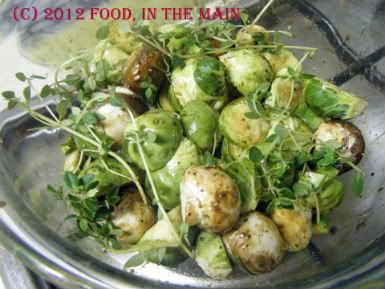 Toss all the ingredients together well, and roast in the oven for 20-25 minutes at 200C (about 390F), until the sprouts are caramelised and cooked. Check on them after 20 minutes, and do not let them get mushy. Serve warm as a side dish. I like it as a snack too.
BALSAMIC ROASTED BRUSSELS SPROUTS AND MUSHROOMS
Ingredients:
12-15 medium sized brussels sprouts, trimmed and sliced vertically in half
10 baby chestnut mushrooms, wiped clean
1 tbsp good quality balsamic vinegar
1 tbsp Worcestershire sauce
1 tsp olive oil or 2-3 sprays of Pam
1/2 tsp dried thyme or a few sprigs of fresh (I used lemon thyme)
Salt and freshly-milled pepper to taste
Method:
Toss all the ingredients together well, and roast in the oven for 20-25 minutes at 200C (about 390F), until the sprouts are caramelised and cooked. Check on them after 20 minutes, and do not let them get mushy. Serve warm as a side dish. I like it as a snack too.
Toss all the ingredients together well, and roast in the oven for 20-25 minutes at 200C (about 390F), until the sprouts are caramelised and cooked. Check on them after 20 minutes, and do not let them get mushy. Serve warm as a side dish. I like it as a snack too.
BALSAMIC ROASTED BRUSSELS SPROUTS AND MUSHROOMS
Ingredients:
12-15 medium sized brussels sprouts, trimmed and sliced vertically in half
10 baby chestnut mushrooms, wiped clean
1 tbsp good quality balsamic vinegar
1 tbsp Worcestershire sauce
1 tsp olive oil or 2-3 sprays of Pam
1/2 tsp dried thyme or a few sprigs of fresh (I used lemon thyme)
Salt and freshly-milled pepper to taste
Method:
Toss all the ingredients together well, and roast in the oven for 20-25 minutes at 200C (about 390F), until the sprouts are caramelised and cooked. Check on them after 20 minutes, and do not let them get mushy. Serve warm as a side dish. I like it as a snack too.
And this time it's REAL gravy, the Western kind, not the inadequate translation of some South Indian kuzhambu into English!
Yesterday's supper for Pete was sausages and mash (mashed potatoes), and he was hankering after onion gravy to go with it. So I looked through some gravy recipes online and discovered that it's not exactly a complicated thing to make. The main ingredients are onions and stock.
I don't usually go to the trouble of making stock from scratch, so I used a fancy pork-flavour Knorr stock cube (the one currently being peddled by chef Marco Pierre White on TV) to make the stock. I'm sure a vegetarian stock cube will do just as well, for those of you who are purists. They probably taste the same, anyhow.
Anyway, the secret to a lipsmacking onion gravy lies in the way the onions are cooked - basically with some butter, long and slow, till they are brown and caramelised BUT NOT BURNT. The balsamic vinegar is the final touch.
The onion gravy was oh-my-GOD yummy and savoury - the balsamic giving that extra oomph, if you ask me. I barely managed to get some photos before Pete whisked away his plate.
Onion gravy is not particularly photogenic, especially in my hands - I'm a crap photographer. So that's why the mash and gravy look the way they do in the photos... but if flavour could be uploaded into the pix, believe me, you'd totally be licking your computer screens!
Recipe for: Onion gravy
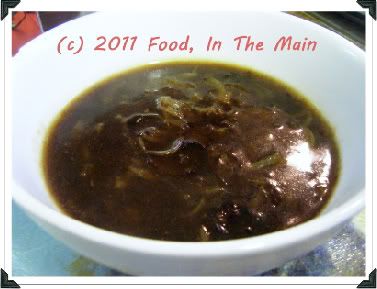 Ingredients:
2 medium onions, halved and sliced thinly
2-1/2 cups stock, instant or home-made
1/2 tbsp good quality balsamic vinegar
3/4 tsp butter
1 tsp sugar
1 tbsp cornflour
1 tsp oil (any mild/flavourless oil)
Pepper and salt to taste
Method:
1. Heat the butter and oili n a saucepan, add the sliced onion and stir well. Fry the onions on medium-high heat for 3-4 minutes, stirring, until they just start to turn colour.
2. Then turn the heat right down, cover the pan and let the onions cook for 10 minutes or till they are brown and soft.
3. Now stir in the sugar and balsamic vinegar and cook the onions for 2-3 minutes on medium-low heat.
4. Then pour in the stock and bring to a boil. After 2-3 minutes, dissolve the cornflour in some water (or in some stock taken from the pan) and add it to the gravy.
Ingredients:
2 medium onions, halved and sliced thinly
2-1/2 cups stock, instant or home-made
1/2 tbsp good quality balsamic vinegar
3/4 tsp butter
1 tsp sugar
1 tbsp cornflour
1 tsp oil (any mild/flavourless oil)
Pepper and salt to taste
Method:
1. Heat the butter and oili n a saucepan, add the sliced onion and stir well. Fry the onions on medium-high heat for 3-4 minutes, stirring, until they just start to turn colour.
2. Then turn the heat right down, cover the pan and let the onions cook for 10 minutes or till they are brown and soft.
3. Now stir in the sugar and balsamic vinegar and cook the onions for 2-3 minutes on medium-low heat.
4. Then pour in the stock and bring to a boil. After 2-3 minutes, dissolve the cornflour in some water (or in some stock taken from the pan) and add it to the gravy.
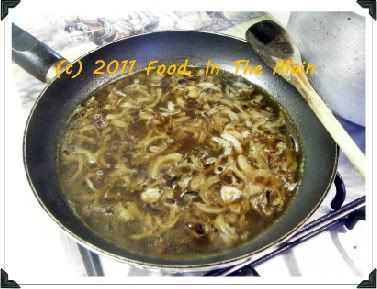 5. Stir well, then add salt and pepper to taste. Let the gravy simmer till it thickens. Ideally, it should not be runny.
5. Stir well, then add salt and pepper to taste. Let the gravy simmer till it thickens. Ideally, it should not be runny.
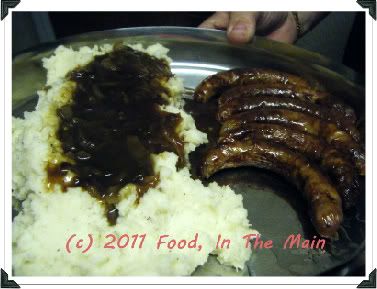 Serve hot with vegetarian (or real) sausages and mashed potatoes for a very English supper.
RECIPE: ONION GRAVY
Ingredients:
2 medium onions, halved and sliced thinly
2-1/2 cups stock, instant or home-made
1/2 tbsp good quality balsamic vinegar
3/4 tsp butter
1 tsp sugar
1 tbsp cornflour
1 tsp oil (any mild/flavourless oil)
Pepper and salt to taste
Method:
1. Heat the butter and oili n a saucepan, add the sliced onion and stir well. Fry the onions on medium-high heat for 3-4 minutes, stirring, until they just start to turn colour.
2. Then turn the heat right down, cover the pan and let the onions cook for 10 minutes or till they are brown and soft.
3. Now stir in the sugar and balsamic vinegar and cook the onions for 2-3 minutes on medium-low heat.
4. Then pour in the stock and bring to a boil. After 2-3 minutes, dissolve the cornflour in some water (or in some stock taken from the pan) and add it to the gravy.
5. Stir well, then add salt and pepper to taste. Let the gravy simmer till it thickens. Ideally, it should not be runny.
Serve hot with vegetarian (or real) sausages and mashed potatoes for a very English supper.
Serve hot with vegetarian (or real) sausages and mashed potatoes for a very English supper.
RECIPE: ONION GRAVY
Ingredients:
2 medium onions, halved and sliced thinly
2-1/2 cups stock, instant or home-made
1/2 tbsp good quality balsamic vinegar
3/4 tsp butter
1 tsp sugar
1 tbsp cornflour
1 tsp oil (any mild/flavourless oil)
Pepper and salt to taste
Method:
1. Heat the butter and oili n a saucepan, add the sliced onion and stir well. Fry the onions on medium-high heat for 3-4 minutes, stirring, until they just start to turn colour.
2. Then turn the heat right down, cover the pan and let the onions cook for 10 minutes or till they are brown and soft.
3. Now stir in the sugar and balsamic vinegar and cook the onions for 2-3 minutes on medium-low heat.
4. Then pour in the stock and bring to a boil. After 2-3 minutes, dissolve the cornflour in some water (or in some stock taken from the pan) and add it to the gravy.
5. Stir well, then add salt and pepper to taste. Let the gravy simmer till it thickens. Ideally, it should not be runny.
Serve hot with vegetarian (or real) sausages and mashed potatoes for a very English supper.
I think this is the second recipe on my blog that involves aubergines. In five years plus of blogging, only the second recipe. There is a very good reason for this – I hate aubergines. Pete likes them, though, and occasionally guilt overcomes loathing and I make something specially for him, with the purple horrors as the star ingredient. (The guilt has to build up slowly over the years, as there is an awful lot of loathing to overcome.)
Anyway, this is very definitely an aubergine lover’s dream dish. It’s supposed to be served as a side with grilled lamb chops, but if you’re vegetarian, feel free to dive right in. It’s a pretty dry dish – it might even do well as part of a tapas spread, come to think of it. The onion base tastes absolutely delicious with the garlic and balsamic vinegar and pine nuts, and I am going to make the dish again, at some point, with bell peppers - although I’d probably leave out the raisins. Should do very nicely over spiced couscous, methinks...
Recipe for: Mediterranean-style aubergine
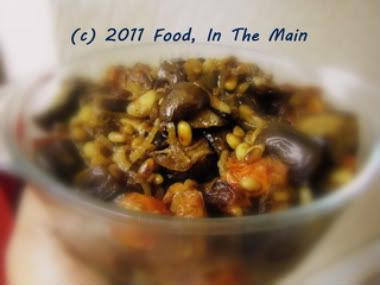
Ingredients:
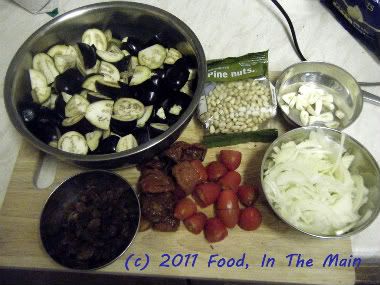
4 cups baby aubergines, quartered
4 cloves garlic, thickly sliced
2 small onions, sliced very fine
2 tbsp extra virgin olive oil
8-10 baby plum tomatoes, cut in half
3 tbsp sundried tomatoes
1 tsp cumin seeds
1/2 tsp cinnamon powder
2 tbsp pine nuts
2 tbsp raisins
2 tsp caster sugar
1 tbsp balsamic vinegar
2 tbsp red wine vinegar
Salt to taste
Method:
1. Heat 1 tbsp extra-virgin olive oil in a large pan and add the garlic and onion.
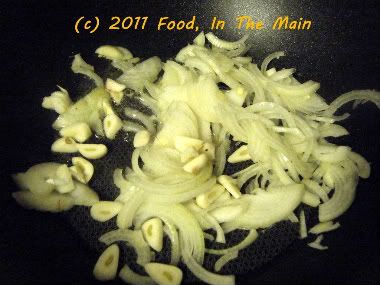
2. Cook for about 5 minutes over a medium heat, until soft and just starting to brown. Remove from the pan and reserve.
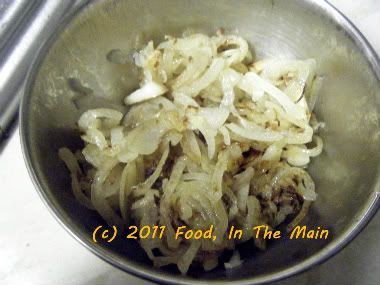
3. Turn up the heat a bit, add the remaining olive oil to the pan. Add the cumin seeds.
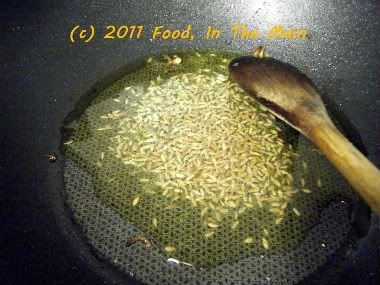
4. Now add the aubergine and fry it, stirring often, for 7-8 minutes, until the aubergine is soft and starting to brown.
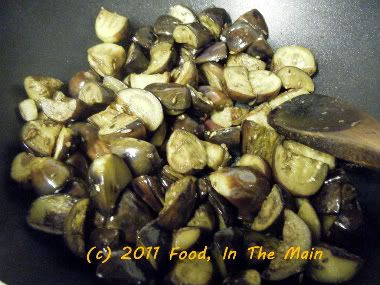
5. Sprinkle in the raisins and pine nuts and stir it all together.
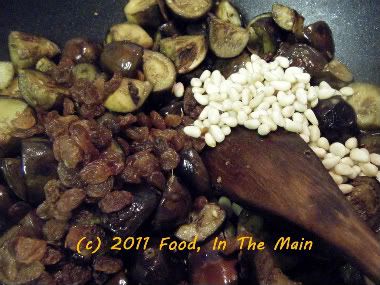
6. Throw in the reserved onion and garlic,

plus the halved plum tomatoes and the ovendried/sundried tomatoes.
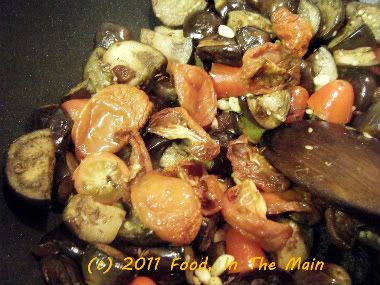
7. Cook for 3-4 minutes, stirring occasionally, until the tomatoes begin to soften.
8. Sprinkle 2 tsp caster sugar and 1 tbsp balsamic vinegar, 2 tbsp white wine vinegar over the aubergine. Stir together until well combined. Add salt to taste, check for seasoning, then remove from the heat.
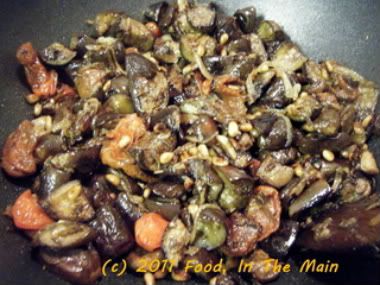
9. Serve warm with couscous, or at room temperature as a snack.
Garnish with a few mint leaves sliced into strips.
RECIPE: MEDITERRANEAN-STYLE AUBERGINE
Ingredients:
4 cups baby aubergines, quartered
4 cloves garlic, thickly sliced
2 small onions, sliced very fine
2 tbsp extra virgin olive oil
8-10 baby plum tomatoes, cut in half
3 tbsp sundried tomatoes
1 tsp cumin seeds
1/2 tsp cinnamon powder
2 tbsp pine nuts
2 tbsp raisins
2 tsp caster sugar
1 tbsp balsamic vinegar
2 tbsp red wine vinegar
Salt to taste
Method:
1. Heat 1 tbsp extra-virgin olive oil in a large pan and add the garlic and onion.
2. Cook for about 5 minutes over a medium heat, until soft and just starting to brown. Remove from the pan and reserve.
3. Turn up the heat a bit, add the remaining olive oil to the pan. Add the cumin seeds.
4. Now add the aubergine and fry it, stirring often, for 7-8 minutes, until the aubergine is soft and starting to brown.
5. Sprinkle in the raisins and pine nuts and stir it all together.
6. Throw in the reserved onion and garlic, plus the halved plum tomatoes and the ovendried/sundried tomatoes.
7. Cook for 3-4 minutes, stirring occasionally, until the tomatoes begin to soften.
8. Sprinkle 2 tsp caster sugar and 1 tbsp balsamic vinegar, 2 tbsp white wine vinegar over the aubergine. Stir together until well combined. Add salt to taste, check for seasoning, then remove from the heat.
9. Serve warm, stirred into couscous, or at room temperature as a salad. Garnish with a few mint leaves sliced into strips.
The orange chocolate cake I’d made previously was so nice that I decided I’d take up a reader’s suggestion (thanks, Shvetha) and try out an eggless version. This time around, I boiled the orange in the microwave for about 10 minutes, in two tranches of 5 minutes each. It could take a couple of minutes more or less, depending on your microwave’s wattage/power, so go easy after the first 5 minutes. Of course, make sure to “drill” the orange through with a skewer, before microwaving it.
I don’t really know first-hand what would happen if you microwaved an orange that was not hole-y (what, did you think I’d pass up the opportunity for a godawful pun?). I don’t think it would explode, at least going by a video I watched on You Tube of three idiotic guys doing exactly that experiment. (I did my research, as you can see.) The orange didn’t explode for them - much to their disappointment - but since I wasn’t sure that my orange would refrain from creating an unhole-y mess in the microwave, it went in sanctified, thereby NOT going kablooey.
Anyway, microwaving the orange is MUCH quicker than cooking it on the hob till it’s soft, and I totally recommend it.
The rest of the ingredients are more or less the same as for the previous cake, sans eggs, of course. I substituted some of the sugar with Splenda, but it's not a "must-do" thing at all. This cake was actually even better than the eggy version, in my opinion – it tasted gooey and moist while looking quite deceptively fluffy. The cake keeps well for a couple of days under cover. I didn’t make any frosting this time, because I didn’t have any chocolate left, but I added ½ cup mini chocolate chips to the batter to intensify the chocolate experience.
Recipe for: Eggless chocolate orange cake
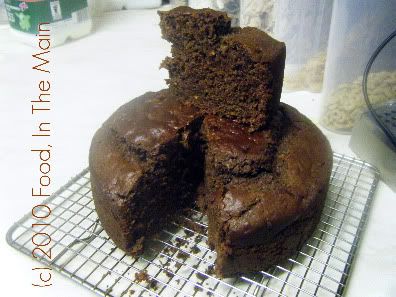
Ingredients:
2-1/4 cup all-purpose flour
2 tsp baking powder
1 tsp baking soda
120 gm dark chocolate, melted
1/2 tsp salt
3/4 cup splenda
1/2 cup sugar
1/2 cup oil
1 large Seville orange
4 tsp vinegar
1 cup milk
2 tsp orange oil extract
1 tsp vanilla extract
1/2 cup mini chocolate chips
Method:
1. Pierce the orange with a skewer 3-4 times, then place in a bowl of water and microwave it for 8-10 minutes.
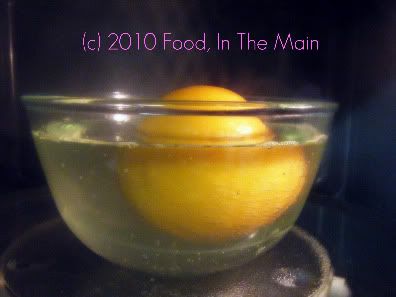
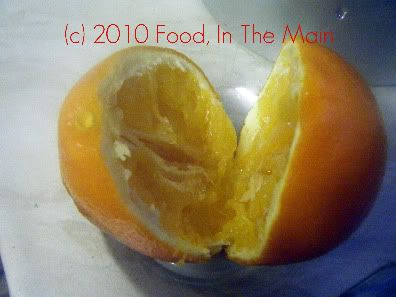
Throw away the water, let the orange cool, then puree it finely. Set aside till required.
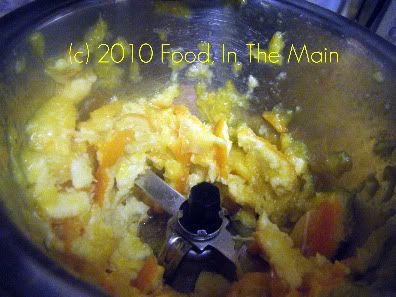
2. Sift the flour, baking soda, baking sugar and salt.
3. Add the sugar and splenda and mix well.
4. Make a well in the centre, and add the melted dark chocolate, the pureed orange, vinegar and oil.
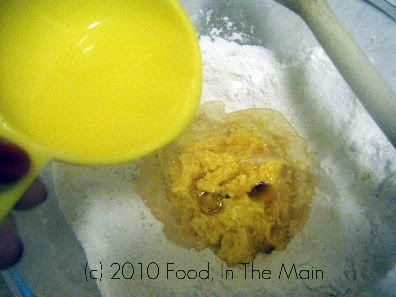
Stir this well, then add the milk and stir till thoroughly mixed.
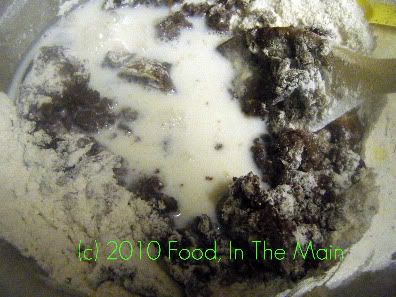
5. Add the orange and vanilla extracts and mix them in.
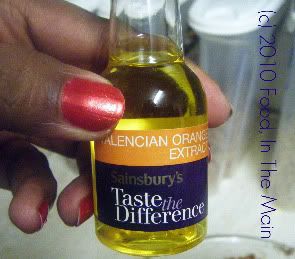
6. Finally, add the chocolate chips and fold them gently into the batter.
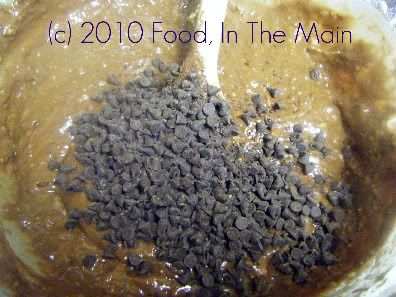
7. Pour the batter into a 9” round baking tin
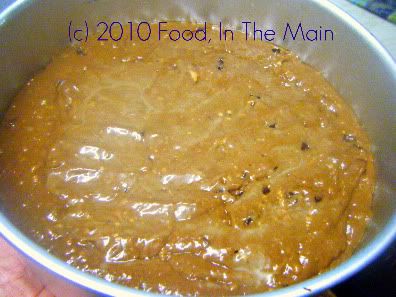
and bake at 180C till the cake tests done – this took about an hour in mine. To be on the safe side, check after 45 minutes.
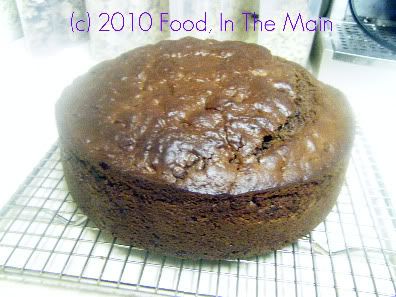
If desired, split the cake and fill with ganache frosting. RECIPE: EGGLESS CHOCOLATE ORANGE CAKE
Ingredients:
2-1/4 cup all-purpose flour
2 tsp baking powder
1 tsp baking soda
120 gm dark chocolate, melted
1/2 tsp salt
3/4 cup splenda
1/2 cup sugar
1/2 cup oil
1 large Seville orange
4 tsp vinegar
1 cup milk
2 tsp orange oil extract
1 tsp vanilla extract
Method:
1. Pierce the orange with a skewer 3-4 times, then place in a bowl of water and microwave it for 8 minutes. Throw away the water, let the orange cool, then puree it. Set aside till required.
2. Sift the flour, baking soda, baking sugar and salt.
3. Add the sugar and splenda and mix well.
4. Make a well in the centre, and add the melted dark chocolate, the pureed orange, vinegar and oil. Stir this well, then add the milk and stir till thoroughly mixed.
5. Add the orange and vanilla extracts and mix them in.
6. Finally, add the chocolate chips and fold them gently into the batter.
7. Pour the batter into a 9” round baking tin and bake at 180C till the cake tests done – this took about an hour in mine. To be on the safe side, check after 45 minutes.
If desired, split the cake and fill with ganache frosting.
I wish I had something witty and clever to say about green beans (or French beans, as they are also known), but I don’t. All I can say is that I love them – the fresher they are, the better. I could never have imagined myself eating plain boiled vegetables – I always thought that would be too bland and boring. But what do you know, the yellow French beans that I’ve grown this summer have mostly been eaten exactly like that... picked from the plant, washed, boiled, sprinkled with a little salt and absentmindedly nibbled down while doing other things.
Given that I liked green beans at their plainest, I had no qualms about not liking them roasted in the oven – although, to be fair, it would NEVER have occurred to me to actually roast green beas. It was Nupur’s post on addictive green beans that set me on that particular track... and the recipe is 99% like hers, except that I used a balsamic vinegar reduction (left over from a previous recipe I’d tried).
Pete was dubious about the edibility of roasted green beans, but I made him try them anyway... and I think perhaps that the balsamic vinegar syrup tilted the balance in favour of the beans. What a lovely recipe!
Recipe for: Roasted green beans
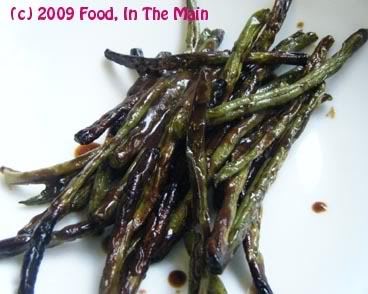
Ingredients:
500gm green beans, topped and tailed
1 tsp olive oil
Salt and pepper to taste
For the dressing:
1 tbsp Dijon mustard
1 tsp honey
2 tbsp balsamic vinegar syrup
Method:
1. Toss the green beans with the olive oil, salt and pepper. Roast at 180C on a baking sheet till they acquire black spots.
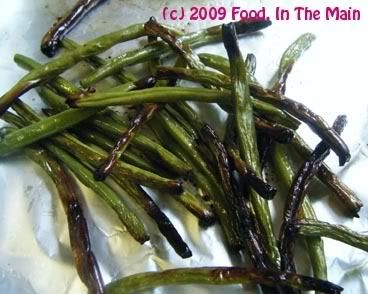
Remove from the oven and let cool for 5 minutes.
2. Place the dressing ingredients in a small bowl and whisk together.

Adjust the flavour to suit your taste, if required.
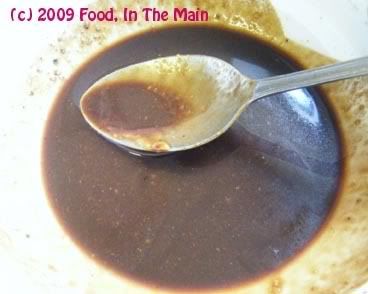
3. Place the beans on a serving plate and pour on the dressing, then serve immediately.
You wouldn’t think that strawberries would pair well with vinegar, would you? Well ok, so it’s not regular vinegar, the kind you’d splash on to your fish and chips (if you ate fish n chips, that is), the kind that is used to pickle onions, etc. It’s balsamic vinegar to which I refer, and that too good quality balsamic vinegar. If you wanted the best quality aged balsamic vinegar, you’d probably have to sell your house to afford it, so I wouldn’t recommend best quality balsamic vinegar - just the good quality balsamic vinegar that costs a few pounds for 250ml, say, from a known brand. I used Balsamic Vinegar of Modena, which I understand is good quality balsamic vinegar.
Ok, now that we have that out of the way (and by the way, I may have qualified for entry into the Guinness Book of World Records for mentioning “balsamic vinegar” the most times in a single paragraph. No, I wasn’t trying to qualify particularly, it’s just one of those lucky things that happen when you mention “balsamic vinegar” many many many many times).
So, my balsamic vinegar from Modena. I had the bottle on my shelf for at least a couple of years – I probably bought it when I read about it but didn't have a clue what to do with it really. So it just sat there in my pantry, probably ageing gracefully. (I like having well-stocked kitchen cupboards - I have more things than I know what to do with, all of which I've bought on the off chance that I might need it for a recipe - because it would be a disaster if I didn't have it when required. Sometimes I think I should just live in a supermarket. That would solve my shelving problems too.)
Anyway, my first actual encounter with balsamic vinegar was at a gastropub a few miles from Shrewsbury. I had an absolutely delicious beetroot salad with a balsamic vinegar reduction for a starter - one bite of that salad, and I was hooked. And then I remembered this recipe on one of my favourite blogs, which was a happy coincidence as I had some really lovely Devonshire strawberries - and a beautiful dessert happened.
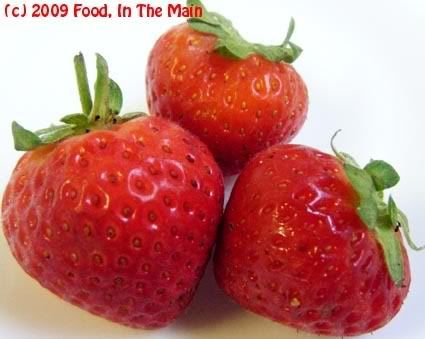
But, aaaack! I didnt have mascarpone cheese (See, this is why I say I should live in a supermarket - I would definitely have had mascarpone cheese at hand!), and I had to wing it with the best substitute I could think of - fat-free Greek yogurt, which I mixed with a tablespoon of sugar... and my poor-man's mascarpone cheese was created.
I dont think I missed the mascarpone, to be honest - the lightly sweetened yogurt tasted wonderful with the strawberries and balsamic vinegar syrup.
Recipe for: Strawberries with balsamic vinegar syrup
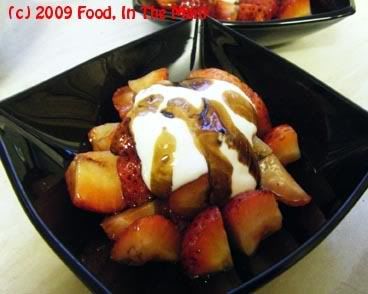
Ingredients:
3 cups (25-30) fresh strawberries, hulled and quartered
1 tbsp vanilla sugar (more or less depending on the sweetness of your berries)
For the syrup:
1/3 cup balsamic vinegar
2 tsp caster sugar
1 tsp fresh lemon juice
To serve:
1/3 cup thick Greek yogurt
2 tsp caster sugar
1 tsp vanilla essence
Method:
1. Sprinkle the vanilla sugar over the strawberries and set it aside for 15-20 minutes.
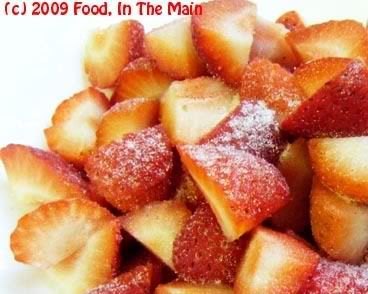
2. Meanwhile, make the balsamic vinegar syrup. Put the sugar in a small pan, squeeze over the lemon juice.
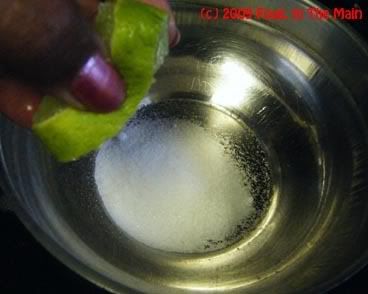
3. Pour the balsamic vinegar over this and stir. Heat the mixture and let the sugar dissolve, then let the vinegar bubble till it's reduced to a syrup that coats the back of a spoon thickly.
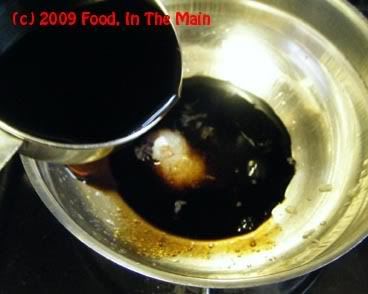
4. Cool the syrup.
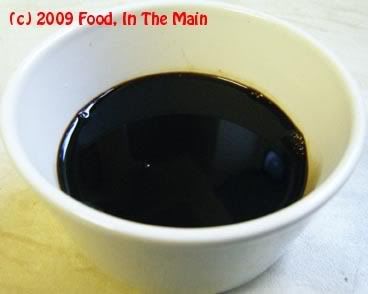
5. Mix the sugar with the Greek yogurt and the vanilla extract
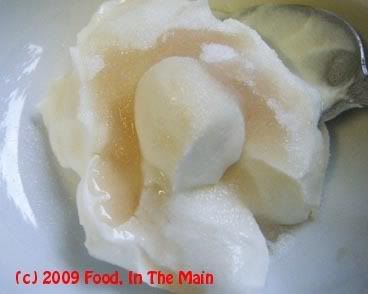
till it's a smooth but still thick "sauce".
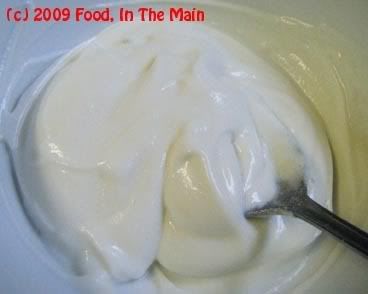
To serve, toss the strawberries lightly with a tablespoon of the vinegar syrup, then portion them out into serving bowls. Dollop a tablespoon of the Greek yogurt on top, drizzle with some more syrup and serve.








































